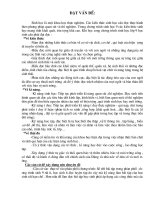chuyen de day listening
Bạn đang xem bản rút gọn của tài liệu. Xem và tải ngay bản đầy đủ của tài liệu tại đây (95.32 KB, 13 trang )
Principles behind the
teaching of listening
1 -The tape recorder is just as important as the
tape.
2 - Preparation is vital.
3 -Once will not be enough.
4- Students should be encouraged to respond to
the content of a listening.
5- Different listening stages demand different
listening tasks.
6- Good teachers exploit listening texts to the full.
Stages in a listening lesson
1 Before listening
2 While listening
3 After listening
Before you listen
Open
prediction
The teacher (T) establishes a context and
introduces the topic of a text. Ss are required
to guess what they are going to listen to. T
writes the Ss’ guesses on the board. Ss are
asked to listen to the text to check if things
they guess are correct or not.
Pre-questions
T writes a few questions on the board. These
questions should focus on the main ideas of
the text. T gives students a few minutes to
guess the answers to the questions. It
doesn’t matter if Ss can’t guess correctly.
True/false
prediction
T writes 5 – 10 statements about the main points
of a text. Half of the statements are true, and the
other half are false. Ss are asked to work in pairs
and decide if the statements are true or false. T
writes the students’ guesses on the board. Ss are
asked to listen to the text to check the answers.
While you listen
Multiple
choice
T prepares questions about the ideas in the
listening text. For each question, there are
three or four options for students (Ss) to
choose from.
Ordering
pictures
Gap-fill
T prepares some simple pictures to describe a
story or a text, and sticks them on the board
randomly. Ss listen to the text and arrange the
pictures in the correct order.
T writes a short paragraph with several
blanks in it. The blanks can be lexical or
grammatical items or both. Ss listen and fill
each blank with information they hear.
T writes about 6 to 8 statements on the
Ordering
statements/events main points of a text but the statements
are jumbled. Ss listen to the text to find
out the order of the statements.
True/false
statements
T writes some true and some deliberately false
statements about the text on the blackboard.
Then Ss listen to the text to find out which are
correct.
Comprehension
questions
These are the questions related to the main
ideas of a text to check students’
comprehension. Ss listen and answer
questions from T or from the textbook.
After you listen
Short written
texts
Retelling the
story
Ss write letters, postcards, messages,
diaries, etc. based on the listening text or
to extend it.
Ss retell the story in groups, using their own
word or using some provided cues.
Discussion
Ss discuss similar or related issues based on
prompt questions or pictures.
Role play
Ss continue the story or situation by assuming
the roles of people in the texts.
Summarizing
Ss summarize the whole text or pre-selected
part orally or in writing.
Designing a listening test
•
1.
2.
3.
4.
Some reminders on the listening
passage
Length
Lexical density
Use of words
Grammatical patterns
•
1.
2.
3.
4.
5.
6.
7.
Some common types of listening tasks
Matching
Gap-filling
True/False statements
Short answers
Multiple choice questions
Answer the questions
Table/graph completing









